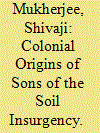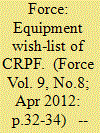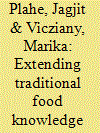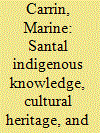| Srl | Item |
| 1 |
ID:
182422


|
|
|
|
|
| Summary/Abstract |
What is the role of colonial institutions in creating the conditions for nativist sons of the soil (SoS) insurgency? The literature on sons of the soil conflicts has not explored the historical legacies of colonial institutions, nor has it sufficiently analyzed how land tenure institutions create sons of the soil conflict. I address these gaps, by proposing a theory of how British colonial indirect rule and land tenure institutions in India caused exploitation of land resources of indigenous tribes by ethnic outsiders, which caused SoS grievances that persisted through path dependence and were later mobilized by Maoist rebels in the former princely state of Bastar in Central India. I show generalizability of this mechanism to other cases of leftist insurgency in Colombia, Mexico and Philippines.
|
|
|
|
|
|
|
|
|
|
|
|
|
|
|
|
| 2 |
ID:
112029


|
|
|
| 3 |
ID:
154560


|
|
|
|
|
| Summary/Abstract |
Small farmers, who are normally dependent on marketing intermediaries, have formed themselves into co-operatives in the Indian states of Telangana, Andhra Pradesh and Maharashtra and have started to sell their produce directly to consumers via retail outlets, the Internet, urban franchises, mobile vans, rural food hubs and as branded products. The key engine for this marketing experiment is the Sahaja Aharam Producer Company Limited (SAPCO), a producer organisation. SAPCO has tried to create new supply chains that guarantee that the produce it sells complies with the quality standards needed to certify the foods as ‘organic’. SAPCO is an initiative of the Centre for Sustainable Agriculture (CSA) which has taken up the bulk of the financial and administrative burden of managing the company. The revival of traditional knowledge for organic farming and the marketing of organic produce has invariably required the intervention of external agents such as CSA. In the final section, we assess the achievements of SAPCO from the viewpoint of the small farmers who belong to the producer co-operatives that make up SAPCO's membership. Our key research question is whether it has been possible to scale up the production and marketing of small farmers’ output and create a new supply chain independent of local intermediaries.
|
|
|
|
|
|
|
|
|
|
|
|
|
|
|
|
| 4 |
ID:
187282


|
|
|
|
|
| Summary/Abstract |
Using different archives, I show how indigeneity was constructed by the Santal themselves during the second half of the nineteenth century, through various figures such as rebels and prophets. This has produced a Santal indigenous knowledge at the interface of orality and writing, revolving around two dimensions—an emergent historical consciousness and a feeling of shared identity, which still informs Adivasi resistance today, enabling them to voice assertion over natural resources. The sacralization of the landscape through pilgrimages and ritual commemorations entails the liberation of formerly encompassed identities, allowing the subaltern communities a certain visibility in the public sphere. Providing a new imagining against dispossession and memory loss, indigenous knowledge, which combines multi-scripturality and ritual innovations, becomes a resource for politics of representation as well as of a common Santal identity.
|
|
|
|
|
|
|
|
|
|
|
|
|
|
|
|